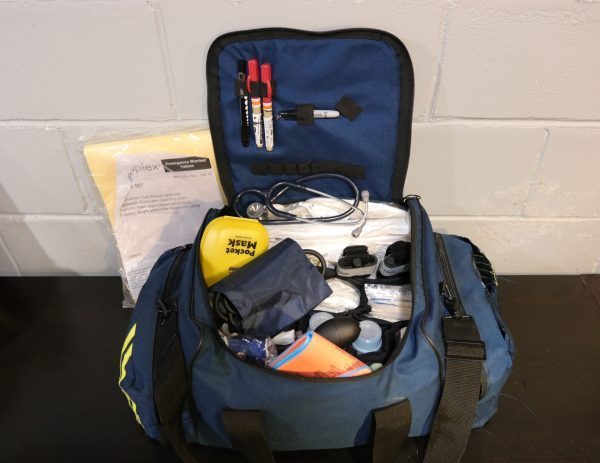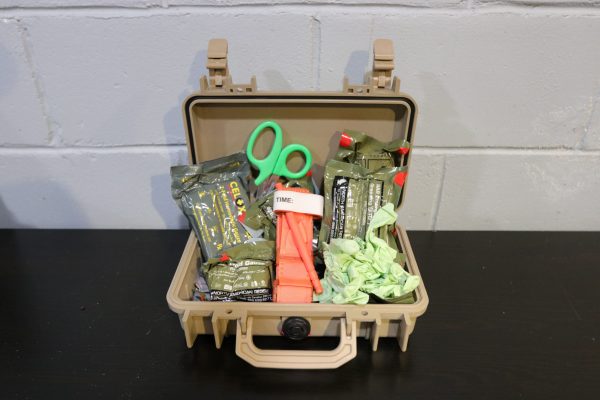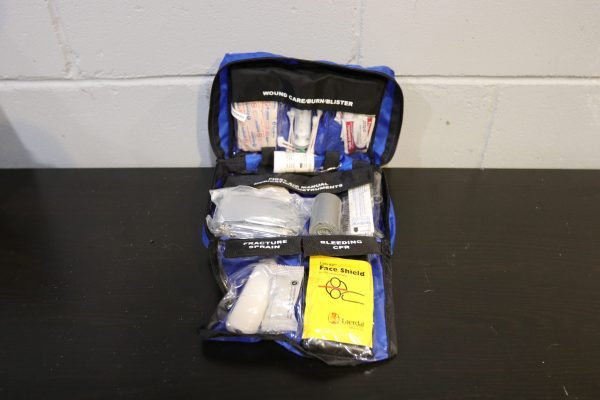
There is nothing like hitting the open road on an RV journey and looking forward to all the fun experiences that this lifestyle brings, but are you prepared for a medical emergency? Are you carrying a first aid/trauma kit in your RV and are you trained on how to use its contents? A long time ago I became a Boy Scout and learned a very important motto, “Be Prepared.” This motto has served me very well. We should all be prepared. I often hope to never have to use any of these items, but I am well prepared to do so if needed.
The American Association for the Surgery of Trauma states that injury in the United States accounts for over 150,000 deaths each year and over 3 million nonfatal injuries each year. At some point in time, you may be involved in a situation either directly or indirectly in which a traumatic injury has occurred. Having the right equipment and knowledge to help in that situation is critical and it can lead to a life-changing outcome. Putting together your own first aid/trauma kit is not a difficult task. If you are apprehensive about all the different items needed for a complete kit you can purchase a pre-stocked first aid/trauma bag from a number of medical suppliers. The one upside of making your own kit is that you will see each item you receive and know where you put it. If you do order a pre-stocked kit make sure you take it apart and learn where all the items are, so when you need something, you will know where it is.
A First Aid / Trauma Bag can be big or small and can contain a lot of supplies or a few basic supplies. It is important to consider what you will need for you and your family and if you plan to help assist another person in the event you come across an accident. As a Paramedic, I carry a large number of supplies in my trauma bag which is kept in my personal vehicle and in our RV as well as a separate First Aid kit with basic supplies for small cuts, scrapes, and abrasions. Below is a list of everything I carry. Please keep in mind that I am trained to use all of these items and not every item may fit your need or want. Keep an eye out for future articles on how to use some of these first aid items.
Trauma Bag
You can purchase a specific bag made for emergency medical supplies or you can use any bag from a backpack to a duffel bag to hold your supplies. The bag should be easy to open and allow you to easily see the contents inside. You can even just use a plastic container and mark it “First Aid” so you can find it easily.

- Bleeding Control Items
- 4×4 Sterile Gauze Pads
- 5×9 Sterile Gauze Pads
- 12 x 30 Trauma Dressing
- 3” Rolled Gauze, 4” Rolled Gauze, 6” Rolled Gauze
- Quik Clot hemostatic dressing
- Pressure Bandage
- CAT Tourniquet x 4
- Chest Seals
- ½”, 1” and 2” Medical Tape
- Sharpie Marker
- Notepad with pen
- Latex gloves.
- Instant Cold and Hot Packs
- Triangle bandages for use with splints/slings
- SAM Splints for splinting fractures
- Elastic Bandage
- Cervical Collar Adult and Pediatric
- Burn Blanket
- Pocket CPR Mask
- Sterile Water and Sterile Saline.
- Blood Pressure Cuff for Adult and Kids
- Pulse Ox Finger Monitor
- Stethoscope
- Trauma Scissors and Penlight
- 50cc Syringe for wound irrigation
- 250 ml NS bag
- Rescue Blanket
Massive Hemorrhage Kit
In addition to our main trauma bag, we have a quick emergency Massive Hemorrhage kit. I store these supplies in a small pelican case and it is readily accessible by the entrance to our RV or if we are in our Jeep it is kept under the driver’s seat. This kit serves the purpose of being able to stop a massive hemorrhage quickly and while using this kit I can ask my wife or another person to get the main trauma bag. If there is one kit to have this would be it. Below is a list of items I keep in this kit. You can also purchase a pre-made kit from StoptheBleed.org, North American Rescue, or any other pre-made massive hemorrhage kit.

-
- CAT Tourniquet w/ Sharpie Marker
- Hemostatic Gauze
- 2 Pressure Dressings
- 2 Rolled Gauzes
- Trauma Scissors
- 2 Chest Seals
- Latex Gloves
First Aid Kit
Finally, a small first aid kit is essential while being on the road. Small cuts, scrapes, and abrasions do not warrant a trip to the emergency room, and having some over-the-counter medications will help to treat minor illnesses. This is a rather easy kit to make and I am sure a lot of you will have 80% of these items readily available. We keep the following items in a small first aid kit in our cupboard for easy access.

-
- Adhesive Bandages – assorted sizes
- Steri Strips for larger cuts
- Moleskin for blisters
- Antibiotic Ointment for wounds.
- Silvadene Topical Cream for minor burns.
- Baby Aspirin
- Tylenol
- Motrin Adult and Kids
- Antiseptic Wipes
- Tweezers
- Benadryl
- Calendula cream
- Thermometer – Oral and Rectal
- Antacid like Tums
- Aloe Vera
- Duct Tape
- Safety Pins
Mix It Up!
The biggest takeaway is that you can make one kit/bag with a mix of the above items. This is truly customizable for you and your family and your RV situation. I have been involved in EMS for over 10 years now and have had a lot of time to accumulate these items and tweak our setup. If money is an issue you can always start with a small number of medical supplies and just add an item as time goes on. Please don’t forget that having these items does not make you proficient at using them. If you are not trained in First Aid and CPR you can easily take a course through the American Red Cross, Stop the Bleed.org or find a local agency by you that teaches a course.
Be Well!
JP Latkovic (F506297) is a New York State Paramedic, Nationally Registered Paramedic, and Certified Flight Paramedic currently working as a Critical Care Transport Paramedic and Flight Paramedic for a Level 1 Trauma Center on Long Island, NY. Their family is transitioning to full-time RV living.


Leave a Reply